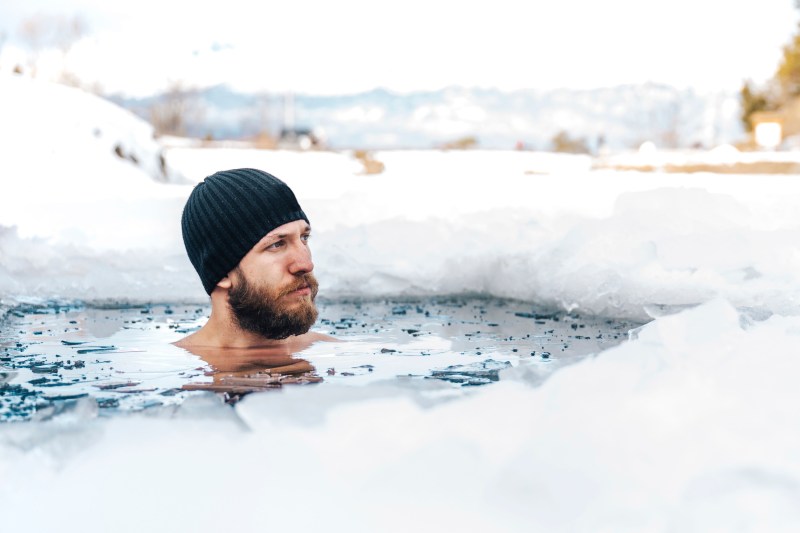
The Wim Hof Method, developed by the renowned “Iceman” Wim Hof, has taken the world by storm with its extraordinary benefits for physical and mental well-being. This method combines specific breathing exercises, cold exposure, and mindset techniques to unlock the hidden potential within our bodies. But what, exactly, is it?
There are three crucial factors of the Wim Hof Method, all of which we’ll explain. But before trying it out, be sure to consult your doctor or healthcare professional, especially if you have underlying conditions.
The Wim Hof Method
Wim Hof was born in the Netherlands in 1959 and showed a fascination with the cold at an early age. His method’s foundation was laid when he started experimenting with cold exposure and found that he could endure extremely low temperatures for prolonged periods without showing signs of hypothermia or frostbite.
Over time, Hof developed his technique to include an assortment of breathing exercises, cold exposure, and mindset, which allowed him to break many Guinness World Records like the longest time spent submerged in an ice bath. He has climbed Mount Kilimanjaro in shorts, ran a marathon in the Arctic Circle, and holds the record for the farthest swim under ice. With results like this, many others have followed in his footsteps.
Here’s how he does it:
Wim Hof breathing method
At the core of the Wim Hof Method lies the powerful Wim Hof breathing method. This specialized breathing exercise involves deep, rhythmic breaths followed by exhalation, enabling practitioners to oxygenate their bodies more efficiently. The technique is inspired by meditation and yogic breathing practices and aims to alter the body’s pH levels, reduce stress, and increase alkalinity.
The Wim Hof breathing method serves to activate the body’s parasympathetic nervous system, which helps in relaxation and counteracting the effects of stress. As a result, practitioners experience improved focus, reduced anxiety, and enhanced emotional well-being. This controlled breathing pattern also influences the immune system, leading to increased resilience against illnesses and diseases.
Cold exposure
You won’t be able to spend long periods of time in the cold if you don’t practice. That’s why the second pillar of the Wim Hof Method is cold exposure, which involves immersing oneself in cold environments or taking cold showers regularly.
When first starting out, Dr. Alexis Shields recommends that you start with a minimum of three times per week. Start small and slow, and drop down the temperature for 2-5 minutes to gradually build your tolerance. Wim Hof’s astonishing ability to withstand extreme cold temperatures demonstrates the incredible potential of cold exposure on the human body.
Cold exposure is believed to have numerous health benefits, including:
- Enhanced circulation: Exposure to cold triggers vasoconstriction and vasodilation, which can lead to improved blood circulation and overall cardiovascular health.
- Increased brown fat activation: Cold exposure stimulates the activation of brown adipose tissue, commonly known as brown fat. Brown fat helps burn calories to generate heat, potentially aiding weight management.
- Reduced inflammation: Cold exposure is thought to reduce inflammation levels in the body, which can have positive effects on conditions like arthritis and muscle soreness.
- Strengthened immune system: Regular cold exposure has been associated with an increase in the number of immune cells, leading to a more robust immune response.
Mindset techniques
Your mindset is a critical part of the process. Like any discipline, cold exposure is often not the most enjoyable thing to experience, but perseverance is key. Hof’s mindset techniques emphasize the power of the mind in achieving seemingly impossible feats. Through mental training and meditation, practitioners of the Wim Hof Method learn to focus their minds to cultivate a strong mindset and resilience.
- Intention setting: The Wim Hof Method emphasizes the power of intention. Before beginning a session, practitioners are encouraged to set clear intentions and goals. By consciously directing their focus and energy toward specific outcomes, individuals can enhance their overall experience and results.
- Mindful breathing: Find a safe and comfortable position, and start by exhaling all the air in your lungs through your mouth. Then, inhale deeply and slowly through your nose, expanding your chest and stomach until you’re full. Control your exhalation, and then repeat the cycle.
- Body scanning: Body scanning is a common technique in mindfulness and meditation practices. In the context of the Wim Hof Method, practitioners are guided to scan their bodies during cold exposure to observe how the cold affects different areas. By cultivating this awareness, individuals can consciously relax tense muscles and embrace the sensations rather than resisting them.
- Focus on the present moment: Like many meditation practices, the Wim Hof Method emphasizes being fully present in the moment. Whether it’s during the breathing exercises or cold exposure, individuals are encouraged to let go of distractions and thoughts about the past or future, and immerse themselves in the present experience.
- Mental visualization: Practitioners are taught to visualize the flow of energy throughout their bodies during the breathing exercises and cold exposure. This visualization helps in directing energy to specific areas and promoting a sense of control over the body’s physiological responses.
- Mind over matter: One of the most transformative aspects of the Wim Hof Method is the emphasis on the power of the mind over the body. Individuals learn to face and overcome fears, doubts, and limitations. This mental fortitude is essential for enduring extreme cold exposure and achieving seemingly impossible physical feats.

The Wim Hof Method offers a different approach to enhance your physical and mental well-being. By incorporating these three techniques, we can tap into the hidden potential of our bodies and minds, leading to improved immunity, reduced stress, increased energy levels, and overall better health.




